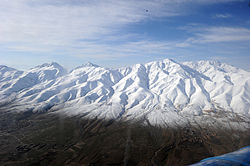Central Afghan Highlands
| |
|---|---|
 Snow-covered mountains in Ghazni | |
| Coordinates: 35°N 68°E / 35°N 68°E | |
| Area | |
| • Total | 414,000 km2 (160,000 sq mi) |
| Dimensions | |
| • Length | 1,000 km (600 mi) |
| Highest elevation | 7,708 m (25,289 ft) |
| Lowest elevation | 1,500 m (4,900 ft) |
| Time zone | UTC+4:30 |
The central Afghan highlands, or the Afghan Highlands (Dari/Persian: افغانستان کوهستانی; Pashto: غرنی افغانستان), is a geographic region of Afghanistan. Stretching from the Sabzak Pass near Herat in the west to the Little Pamir in the northeast, it includes the main Hindu Kush range and forms a western extension of the Himalayas. It is a highland area of more than 1,500 m (4,900 ft) above sea level, mostly situated between 2,000 and 3,000 m (6,500 and 9,800 ft), with some peaks rising above 6,400 m (21,000 ft). Usually, the valley bottoms in the area are used for cereal and horticultural production, and the mountains and high plateaus are used as pasture in summer for grazing sheep, goats, cattle, and camels. Its total area is about 414,000 km2 (160,000 sq mi).[1][2]
The region contains about 225,000 km2 (87,000 sq mi) of summer pasture, which is used by both settled communities and nomadic pastoralists like the Kuchis. Major pastures in the region include the Nawur pasture in northern Ghazni Province (whose area is about 600 km2 at elevation of up to 3,350 m), and the Shewa pasture and the Little Pamir in eastern Badakhshan Province. The Little Pamir pasture, whose elevation is above 4,000 m (13,000 ft), is used by the Afghan Kyrgyz to raise livestock.[1]
The region includes Bamyan, Ghazni, Ghor, Logar, Nuristan, Paktia, Paktika, Panjshir, Parwan, and Maidan Wardak provinces, most of Badakhshan, Daykundi, Kabul, and Zabul, and adjacent parts of some neighboring provinces. It is inhabited by the Hazaras, Kyrgyz, Pashtuns, Tajiks, Uzbeks, Wakhis, and other tribes.[1]
- ^ a b c d Ali, Aziz; Shaoliang, Yi. "Highland Rangelands of Afghanistan: Significance, Management Issues, and Strategies" (PDF). Lalitpur, Nepal: International Centre for Integrated Mountain Development: 10. Retrieved 19 October 2021.
{{cite journal}}: Cite journal requires|journal=(help) - ^ Cite error: The named reference
britannicawas invoked but never defined (see the help page).
© MMXXIII Rich X Search. We shall prevail. All rights reserved. Rich X Search
